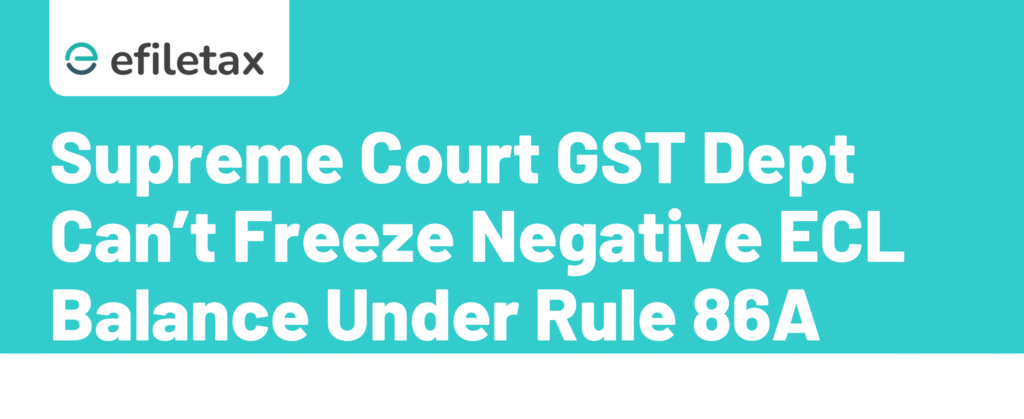
Supreme Court on Rule 86A: No Blocking of Negative Balance in ECL
The Supreme Court has upheld the Delhi High Court’s verdict that a negative balance in the Electronic Credit Ledger (ECL) under GST cannot be blocked under Rule 86A of the CGST Rules, 2017. This decision brings much-needed clarity to taxpayers facing Input Tax Credit (ITC) restrictions.
Let’s simplify this for Indian businesses, consultants, and GST filers.
What Is Rule 86A of CGST Rules?
Rule 86A allows GST officers to block ITC in the Electronic Credit Ledger (ECL) if they believe that:
- ITC is availed fraudulently
- It’s based on fake invoices
- Supplier is non-existent or not paying tax
However, this rule does not mention negative balances or give officers the power to block such negative entries.
The Supreme Court Verdict: Key Highlights
- Case Name: Commissioner of GST vs Samay Alloys India Pvt Ltd
- Bench: Justice B.V. Nagarathna and Justice Augustine George Masih
- Date: June 2024
- Final Word: Rule 86A can only block existing ITC, not a negative balance in the credit ledger.
Delhi High Court Observations (Now Affirmed by SC):
- Negative balance means no ITC is available.
- Blocking an already negative ledger is meaningless and excessive.
- Officers cannot assume powers beyond what Rule 86A allows.
Legal Reference: Rule 86A – CGST Rules, 2017 (gov.in)
What Does Negative Balance in ECL Mean?
A negative balance in the Electronic Credit Ledger occurs when:
- You utilise ITC for filing GSTR-3B, but
- The credit is later held to be ineligible during verification
In such cases, a demand is raised, and your ledger shows a negative amount until you pay it back.
🔍 Important: You can’t use ITC you don’t have. So blocking a negative balance has no legal effect.
Why This Matters for Taxpayers
Before this ruling, GST officers routinely blocked ECLs, even if the balance was already zero or negative. This led to:
- Compliance hurdles
- Cash flow issues for genuine taxpayers
- Litigation and delays in refunds
🧾 This judgment puts a stop to such misuse.
Expert View: Focus on Fair Administration
“This verdict strengthens the taxpayer’s position and sends a message that GST administration must stay within legal limits. Officers must rely on adjudication, not arbitrary blocks.”
— Tax Expert at Efiletax
What Should You Do if ITC Is Blocked?
Here’s what GST-registered businesses should do if they face similar issues:
- Check your ECL regularly via GST Portal
- If blocked without cause, file a grievance using PMT-06/PMT-07
- Seek legal remedy if ITC is blocked despite a negative balance
- Maintain clean documentation and reconciliations for all ITC claims
Comparison: Before vs After SC Ruling
| Issue | Before Verdict | After Verdict |
|---|---|---|
| Negative balance blocked | Officers blocked negative ITC wrongly | Not allowed under Rule 86A |
| Legal clarity | Ambiguity in GST law | Supreme Court settles the interpretation |
| Taxpayer relief | Had to file writs or appeals | Now protected by SC precedent |
Related Reading
- How to Check and Rectify Your Electronic Credit Ledger (ECL)
- CBIC Circulars on Rule 86A Usage – Explained
FAQs on ECL and Rule 86A
Q1. Can GST officers block my ECL if the balance is zero?
No. As per the SC ruling, Rule 86A only applies when credit is available.
Q2. What happens if my ledger is in negative and gets blocked?
That block has no legal effect, and you can challenge it.
Q3. How long can Rule 86A block ITC?
Maximum 1 year, as per the Rule. After that, credit is auto-restored unless extended by legal order.
Summary
The Supreme Court has ruled that negative balances in GST Electronic Credit Ledger (ECL) cannot be blocked under Rule 86A. This judgment protects taxpayers from arbitrary ITC restrictions and clarifies that Rule 86A applies only to available ITC, not to already exhausted or negative credit.
Final Words + CTA
The Supreme Court ruling brings major relief to GST taxpayers. If you’re struggling with wrongful ITC blockage or ECL disputes, our experts at Efiletax can help you challenge it with confidence.